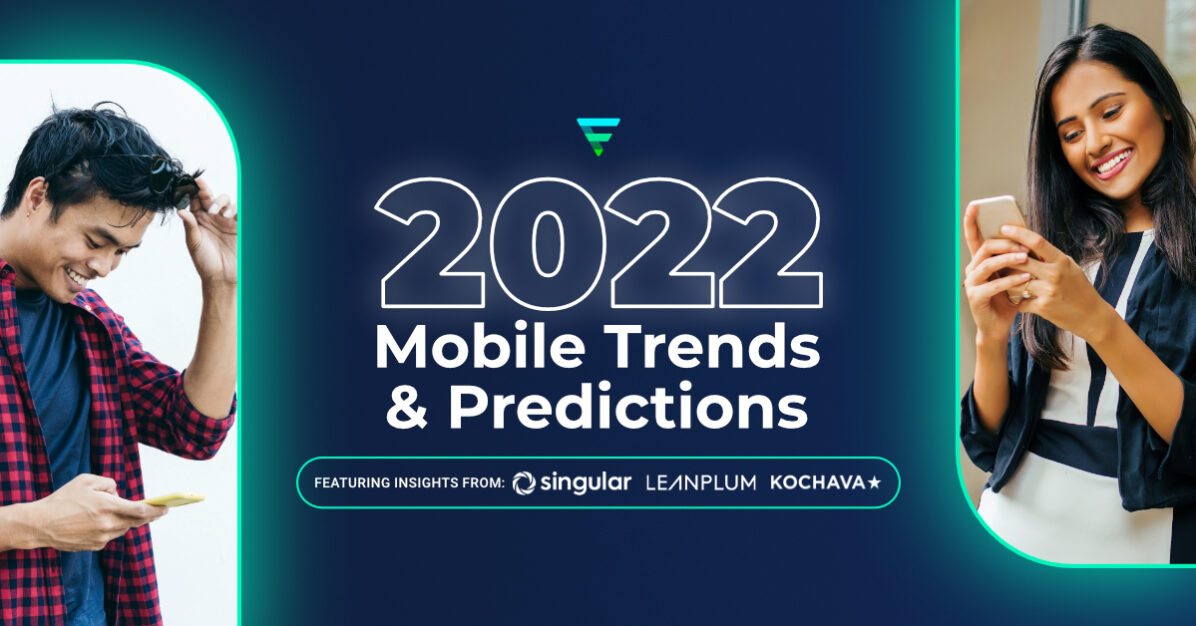Industry Outlook: Mobile App Marketing Trends in 2022

In April 2021, the arrival of Apple’s App Tracking Transparency (ATT) framework ushered in a new era of privacy, limiting the collection of iOS user data and forcing the industry to recalibrate its approach to measurement, attribution, and remarketing. As we kick off 2022, we’ve asked our own internal thought leaders plus experts across the industry to reflect on their learnings from this period of change and share their mobile app marketing trends and predictions for the year ahead.
In this post you’ll find:
- Mobile app marketing learnings from 2021
- Predictions for mobile app marketing trends in 2022
- Tips for navigating the evolving privacy landscape
- Recommended channels for driving sustainable growth
Meet the Mobile App Marketing Experts
Andres Duran, Director of Growth Marketing, Mobile Apps at Fluent, and our friends at Singular, Kochava, and Leanplum weigh in on their key takeaways from the past year and provide tips for navigating the changing mobile app marketing landscape in 2022.

Mobile App Marketing Trends & Predictions
What was your biggest learning from 2021?
Andres Duran, Director of Growth Marketing, Mobile Apps, Fluent
“This past year I spent some time exploring the world of live streaming, more specifically the gaming category, and I was amazed by the level of engagement the communities in these platforms have. Brands are already playing in this space, but I still see a lot of room for new types of integrations that can unlock a very loyal user base.”
Saadi Muslu, Director of Product Marketing, Singular
“2021 brought crazy changes to the marketing space—most notably Apple’s ATT framework. My biggest learning was “be prepared and stay nimble,” and at Singular, the benefit of doing so was crystal clear. Marketers needed help to navigate their new, privacy-centric reality, and we were ready for it, which was critical to our advertisers, and subsequently, Singular’s success in 2021. On a personal note, I think that flexibility was my biggest takeaway—the need to be open and ready for change.”
Jason Hicks, General Manager m/OS, Kochava
“Protect your first-party data. 2021 saw more user privacy changes, evolving data governance with major ad platforms, and a wave of mergers and acquisitions in ad tech. Respecting your customer’s consent across all platforms and your first-party data is your paramount asset and should be carefully guarded, as it will play key roles in the future of audience targeting, campaign measurement, and beyond.”
Andrew Sultzer, Director of Growth Accounts, Leanplum
“After nearly two years since the outset of COVID-19, social commerce has broken out from a niche channel to a primary form of business with consumers. This has allowed brands of all sizes to be far more omnipresent through both organic and paid content with users on a global scale. Rather than focusing on driving business to a standalone location (brick and mortar or a single website), brands are going to TikTok, Instagram, Snapchat, etc. to conduct the entire transaction where their users already are.”
What are some of your predictions for mobile app marketing trends in 2022?
Andres Duran, Director of Growth Marketing, Mobile Apps, Fluent
“We’re going to continue to see the consolidation of UA channels advertisers leverage to drive growth. In the past, user acquisition teams would have a portfolio of 20+ ad networks/channels they would work with concurrently for user acquisition on a single title. That number is dropping quickly as advertisers look for efficiency in a space that is also showing signs of consolidation itself with some headline-making acquisitions in the past year or two.”
Saadi Muslu, Director of Product Marketing, Singular
“Data Modeling for the win: With the continued emphasis on privacy and deprecation of user-level data, more marketing organizations are looking to data modeling to fill in reporting gaps and continue to scale their growth. We’re already seeing this amongst savvy mobile marketers who are able to model for reporting gaps with high levels of confidence to uncover good data — not perfect, but good — actionable insights into what’s working.
Storytelling is the key to engagement: Inspire your audience to act with storytelling marketing that speaks directly to their needs, in their language, and on their preferred mediums/formats. That’s storytelling in video, storytelling by influencer, storytelling with thought leadership backed up by search engine optimization (SEO), storytelling by social audio, and more.”
Jason Hicks, General Manager m/OS, Kochava
“Data clean rooms will play an ever-increasing and crucial role in a privacy-first ad tech ecosystem. The mediators of these clean rooms will be the next-generation mobile measurement partners (MMPs) who already have the infrastructure in place to transact within a secure data locker environment. The beauty of clean rooms is that data permissions enable secure audience enrichment, identity resolution, and even campaign measurement without exposing your data directly to third parties.”
Andrew Sultzer, Director of Growth Accounts, Leanplum
“With the undeniable impact influencers have on consumer traffic, brand loyalty, and conversion events, content creators have more of a say than ever when it comes to getting paid. Apps with fair and transparent pricing models that support creators of all sizes will not only attract bigger names and more people to their platforms, but also work to draw away users from long-standing names in the industry. This combined with the emergence of LiveOps for ecommerce will undoubtedly shake up the market over the next twelve months.”
Considering Apple’s ATT framework and upcoming changes from Google, how can app marketers best navigate the evolving privacy landscape?
Andres Duran, Director of Growth Marketing, Mobile Apps, Fluent
“It can be overwhelming to keep up with changes to user tracking, and by extension, one’s visibility into campaign performance. On the flip side, it’s been great to see how these changes have helped breed innovation and creativity. As app marketers, it’s our responsibility to stay informed and be creative because I can guarantee more changes are on the horizon!”
Saadi Muslu, Director of Product Marketing, Singular
“Advice for gaining your users’ trust, specifically to garner tracking consent:
- The ATT prompt allows you to customize a snippet of text, referred to as the Tracking Usage Description. Test different variations that explain the benefits to the user in a straightforward way. Some user benefits may include ensuring personalized user experiences, helping to keep the app free, or helping to avoid irrelevant ads.
- Leverage a pre-ATT prompt to further alleviate data use concerns and explain the benefits to the user of providing consent.
Advice on navigating privacy changes:
- Set up an internal task force across key functions like marketing, product, BI, and data engineering to quickly adapt to new privacy measures and avoid growth disruption.
- As noted in my marketing predictions, invest in data modeling to ensure you have the data needed to optimize your efforts and futureproof your growth effectively.
- Utilize trusted, compliant solutions rather than shady workarounds. Don’t put your brand reputation on the line. Oh yes, and of course, don’t forget to publicize your stance on compliance!”
Jason Hicks, General Manager m/OS, Kochava
“Find a measurement partner you can build a lasting relationship with to help you navigate the trifecta of user data privacy evolutions across government jurisdictions, device platforms, and major ad networks. Here at Kochava, we sit at a unique intersection to bring your omnichannel worldview into focus despite these differing privacy layers. Further, be upfront and transparent with your users – proactively educating them on how you use their data and why.”
Andrew Sultzer, Director of Growth Accounts, Leanplum
“With the “cookie-pocalypse” imminent for digital advertisers, app marketers will need to develop several contingency plans (if they haven’t already) for how to navigate in a post-third-party cookie world. Early adoption of multiple replacement models and alternative data solutions such as Google’s FLoC will benefit marketers in the short term, but they should prepare for new privacy issues that arise out of the elimination of old ones. Long-term solutions will be learning to leverage frameworks that support a user-controlled, universal online ID that provides greater privacy and protection to the individual.”
What channels should app marketers use to drive sustainable growth in the new year?
Andres Duran, Director of Growth Marketing, Mobile Apps, Fluent
“In the search for efficiency, user acquisition teams should be looking to work with partners like Fluent that not only offer scale but are also flexible enough to adapt to their clients’ goals and play in multiple channels effectively. Almost as important as acquiring new users is retaining them. Invest time and resources in your lifecycle marketing strategy and you will reap the benefits soon enough.”
Saadi Muslu, Director of Product Marketing, Singular
“Omnichannel strategies (being everywhere your users are with consistent branding and messaging) are still the way to go. Consumers are increasingly multi-device; even using several devices at the same time (think playing a mobile game or online shopping while watching Netflix). Mobile marketers saw success in the channels below in 2021:
- Social media platforms like TikTok and Instagram
- Fraud-free mobile ad networks
- App Store Optimization (including Apple’s custom product pages)
- OTT and connected TV
- Search engines
- Influencer marketing”
Jason Hicks, General Manager m/OS, Kochava
“Over-the-top (OTT) / Connected TV (CTV) and even out-of-home (OOH) come to mind. We’re at the forefront of helping marketers measure the incremental lift in online engagement that can be driven via these channels. It’s the ubiquity of mobile and how mature measurement tools have become that are enabling a measure of efficacy via channels and formats that were previously immeasurable. CTV is still a relatively new market that advertisers can take advantage of and incorporate into their overall marketing strategy.”
Andrew Sultzer, Director of Growth Accounts, Leanplum
“An omnichannel presence is essential for every mobile-first company looking to grow, double down on your top producing channels but do not ignore the rest. Invest in LiveOps to connect with your customers in real-time and create a UX that feels organic rather than forced. Also, don’t make ads, make content.”
Looking Ahead: The Future of Mobile App Marketing
If 2021 was a year of groundbreaking changes in privacy, 2022 will be a time for innovation and growth. Mobile marketing measurement and optimization will continue to evolve in 2022 – driven by better data modeling and increased usage of predictive analytics. In the year ahead, mobile app marketers should prioritize transparency and trust as they set out to engage users across channels and deliver a strong value exchange.
If you’re an app marketer interested in scaling your user acquisition efforts and keeping up with the latest mobile app marketing trends, connect with us here or fill out the form below!